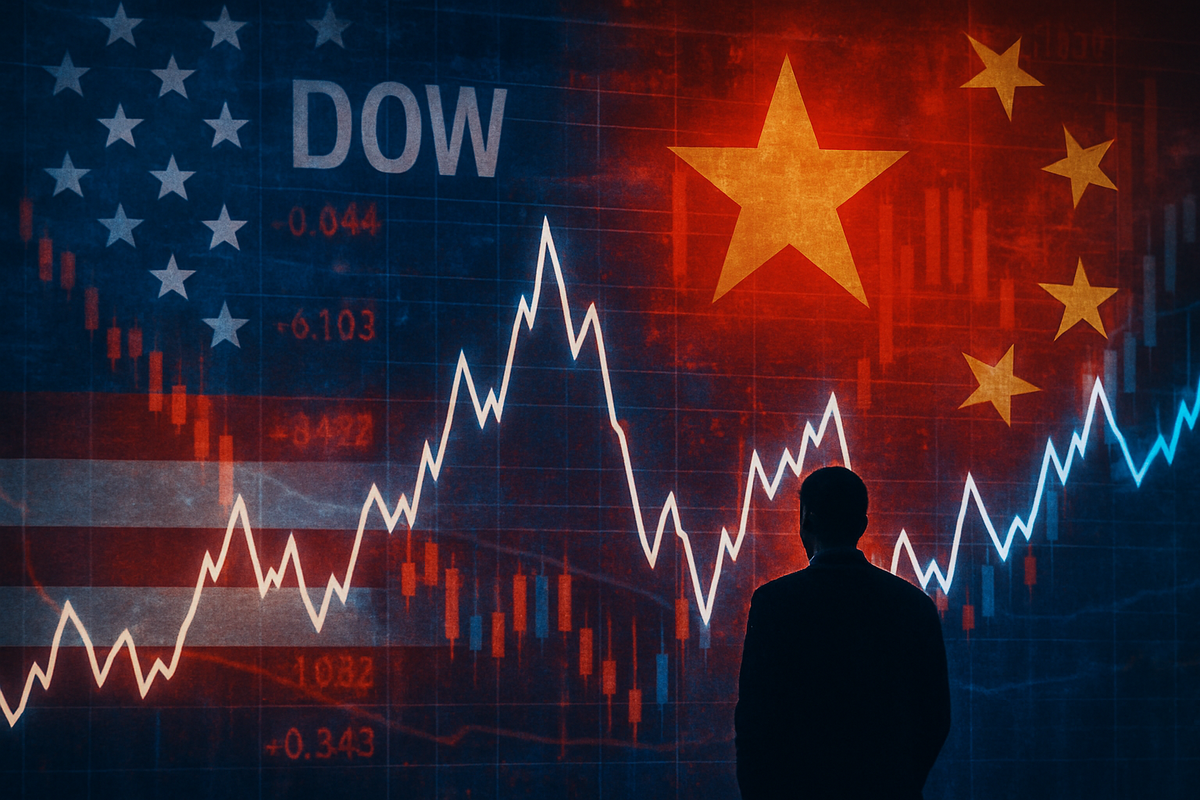
The financial markets have been gripped by a tumultuous week, culminating in significant volatility for the Dow Jones Industrial Average (DJIA). After an initial, sharp decline that erased substantial value, the Dow staged a notable recovery, only to succumb to renewed pressures, signaling a market caught between geopolitical anxieties and underlying economic resilience. This rollercoaster movement has left investors grappling with shifting sentiments and an uncertain outlook, particularly as U.S.-China trade relations remain a primary driver of market swings.
The recent market gyrations highlight a fragile investor confidence, where positive catalysts are quickly overshadowed by geopolitical headwinds. The Dow's ability to claw back a significant portion of its losses, even temporarily, suggests a segment of the market remains optimistic about corporate fundamentals and future growth. However, the subsequent reversal underscores the pervasive impact of macro-level events, particularly the ever-present shadow of U.S.-China trade disputes, on daily market performance and long-term strategic planning.
A Week of Whitetails: The Dow's Battle Against Geopolitical Headwinds
The recent volatility began to escalate on Friday, October 10, when the Dow Jones Industrial Average (DJIA) experienced a significant sell-off, declining by 1.5%. This downturn was triggered by a resurgence of U.S.-China trade tensions, specifically former President Donald Trump's threats of increased tariffs on Chinese imports and China's retaliatory move to implement new export controls on rare-earth materials. The broader market mirrored this decline, with the S&P 500 falling 2.7%—its steepest single-day drop since April—and the Nasdaq Composite tumbling 3.6%. Technology and AI-focused stocks bore the brunt of this initial sell-off, reflecting concerns over global supply chains and demand.
However, a glimmer of optimism emerged over the weekend. President Trump's softened rhetoric on China, where he indicated a desire to "help China, not hurt it," provided a much-needed reprieve. This shift in tone fueled a robust recovery on Monday, October 13, as investor sentiment improved. The Dow Jones Industrial Average (DJIA) rallied impressively, climbing 1.3% (581 to 587.98 points) to settle at 46,067.58, effectively recouping more than half of Friday's losses. The S&P 500 (SPX) also surged 1.6% to 6,654.72, marking its best day since May, while the Nasdaq Composite (IXIC) jumped 2.2% to 22,694.61. This rebound was notably led by AI-related tech stocks, with Broadcom (NASDAQ: AVGO) surging almost 10% after announcing a collaboration with OpenAI, and Nvidia (NASDAQ: NVDA) climbing 2.8%.
The market's brief respite proved fleeting. On Tuesday, October 14, renewed trade tensions dramatically resurfaced, sending U.S. stocks sharply lower once more. China escalated its response by sanctioning five U.S.-associated subsidiaries of South Korean shipbuilder Hanwha Ocean (KRX: 042660), effectively banning Chinese firms from conducting business with them. Simultaneously, both nations began imposing new port fees on each other's vessels, signaling a deepening of the trade dispute. Consequently, the Dow Jones Industrial Average (DJIA) fell 504 points (1.1%), with futures having already slipped before the opening bell. The S&P 500 (SPX) dropped 1.3%, and the Nasdaq Composite (IXIC) slid nearly 2%. Technology and AI-focused stocks, which had led the previous day's gains, were again among the biggest losers; Nvidia (NASDAQ: NVDA) fell more than 3%, Tesla (NASDAQ: TSLA) dropped between 2.5% and 3.8%, and Oracle (NYSE: ORCL) declined between 1.4% and 4.3%.
Initial market reactions on Tuesday were characterized by a significant flight to safety. Investors moved away from risk assets, pushing safe havens like gold to record highs above $4,000 to $4,100 per ounce, and silver to an all-time high of $52.07 to $53.60 an ounce. Crude oil prices fell approximately 2% amid concerns over a potential global demand slowdown. The Cboe Volatility Index (VIX), often referred to as Wall Street's "fear gauge," rose above 22, signaling a heightened level of market uncertainty and expected future volatility. This period underscores how quickly market sentiment can pivot on geopolitical developments, overriding even strong corporate earnings reports from major financial institutions like JPMorgan Chase (NYSE: JPM), Goldman Sachs (NYSE: GS), and Wells Fargo (NYSE: WFC) that had exceeded expectations.
Corporate Fortunes in the Crosshairs: Winners and Losers in a Volatile Market
The escalating U.S.-China trade tensions and the resulting market volatility are creating a clear divide between companies that stand to lose significantly and those that might find opportunities or prove more resilient. Sectors with deep ties to global supply chains and substantial revenue exposure to either the U.S. or Chinese markets are particularly vulnerable to the current geopolitical climate.
Technology companies, especially those in the semiconductor and electronics industries, are at the epicenter of this economic battle. Firms like Nvidia (NASDAQ: NVDA), Micron Technology (NASDAQ: MU), Intel (NASDAQ: INTC), Qualcomm (NASDAQ: QCOM), and Advanced Micro Devices Inc. (NASDAQ: AMD) face a dual threat: increased tariffs on components and potential export controls on critical software and hardware, which can disrupt their complex supply chains and limit market access. Apple Inc. (NASDAQ: AAPL), with its heavy reliance on manufacturing in China, is also directly impacted by rising production costs due to tariffs. Similarly, manufacturers, particularly those with extensive operations in China or a heavy reliance on Chinese intermediates, are experiencing increased costs and supply chain disruptions. Heavy machinery exporters such as Caterpillar (NYSE: CAT) and aircraft companies like Boeing (NYSE: BA) are susceptible to Chinese trade retaliation, potentially losing access to significant markets. Even consumer brands like Nike (NYSE: NKE), Levi's (NYSE: LEVI), and Gap (NYSE: GPS), which depend on Asian factory hubs, face rising production costs that can translate to higher consumer prices. Tesla Inc. (NASDAQ: TSLA), as a U.S. automaker, is exposed to tariffs on vehicles exported to China and challenges within China's automotive supply chain.
Conversely, companies that are less exposed to direct U.S.-China trade flows or those that benefit from strategic shifts in global supply chains may emerge as relative winners. Firms involved in "reshoring" efforts or strengthening domestic supply chains could see increased demand. For instance, transportation companies like Union Pacific (NYSE: UNP) might benefit from increased domestic logistics needs, while industrial technology providers such as Honeywell International (NASDAQ: HON) play a strategic role in critical sectors for reshoring. Construction materials companies like Martin Marietta Materials (NYSE: MLM) could also see a boost from increased domestic infrastructure and manufacturing facility construction. Furthermore, with China restricting rare earth exports, non-Chinese producers such as Critical Metals (ASX: CRML) and MP Materials (NYSE: MP) could experience increased demand and higher prices for these essential materials. Defensive sectors, including healthcare, utilities, and consumer staples, with their stable cash flows and primarily domestic revenue sources, tend to show greater resilience during periods of geopolitical tension and market volatility, offering a degree of shelter for investors.
Financial institutions, despite some reporting strong third-quarter earnings, are operating in a challenging environment. While banks like JPMorgan Chase (NYSE: JPM) and Goldman Sachs (NYSE: GS) might see some areas of strength, overall market volatility and economic uncertainty can lead to reduced dealmaking activity, increased provisions for credit losses, and a more cautious approach to lending. The prevailing anxiety over trade policy can easily overshadow positive earnings, as evidenced by JPMorgan Chase's stock dipping despite better-than-expected profits, with its CEO citing "a heightened degree of uncertainty stemming from complex geopolitical conditions, tariffs and trade uncertainty, elevated asset prices and the risk of sticky inflation." This indicates that even robust financial performance is vulnerable to the broader macroeconomic and geopolitical landscape.
Global Repercussions: A Deep Dive into Deglobalization and Policy Shifts
The renewed escalation of U.S.-China trade tensions on October 14, 2025, has sent profound ripple effects across global economies, accelerating existing trends and reshaping the international trade landscape. This latest friction, characterized by reciprocal tariffs, export restrictions, and sanctions, is not merely a temporary market blip but a significant push towards deglobalization and a fundamental restructuring of global supply chains.
These escalating trade disputes are intensifying the broader trend of deglobalization, a phenomenon visible since 2008 and significantly accelerated by the strategic competition between the U.S. and China, alongside the disruptions of the COVID-19 pandemic. Companies are increasingly adopting "China+1" strategies, actively diversifying their production and supply chains away from China to countries like Vietnam, India, and Mexico. This strategic pivot aims to mitigate geopolitical risks and build more resilient supply networks, driving a push for dual-sourcing critical components and exploring alternative manufacturing locations. The movement towards reshoring and nearshoring is also gaining momentum, as businesses seek to bring production closer to home, albeit requiring substantial capital investment and infrastructure upgrades. This disruption is also accelerating the adoption of technology for supply chain visibility, enabling companies to navigate complex regulatory environments and optimize shipping strategies.
The ripple effects of these tensions are far-reaching, impacting not only equity markets but also bond and commodity markets, and significantly influencing global economic growth. Heightened market volatility, as seen with the Dow's swings, triggers a flight to safety, causing bonds to rally. On October 13, 2025, as trade tensions intensified, 10-year and 2-year Treasury yields fell, indicating investors were seeking safe-haven assets. Commodity markets are also profoundly affected; agricultural commodities, especially soybeans, faced significant disruption in previous trade war rounds, and global crude oil prices plummeted by more than 2% on October 14, hitting a five-month low due to escalating U.S.-China tensions. New reciprocal port fees are expected to increase shipping costs for agricultural exports by 15-20% and manufacturing inputs by 8-12%, contributing to inflationary pressures globally. The International Monetary Fund (IMF) has previously estimated that additional U.S.-China tariffs could subtract about 0.3% of global GDP, with experts warning that a prolonged trade war could severely dampen global economic growth, potentially leading to reduced corporate earnings, increased unemployment, and even a global recession. International partners, particularly those intertwined with U.S. and Chinese supply chains, face pressure to choose sides, impacting their market access or supply chain resilience, as exemplified by China's sanctioning of Hanwha Ocean (KRX: 042660) units.
These events also highlight a significant shift in regulatory and policy approaches. Both the U.S. and China are increasingly weaponizing export controls as a broader trade policy instrument, not just for national security. China's controls on rare earths and the U.S. threat of controls on critical software demonstrate this strategic use of supply chains and technology. Concurrently, both nations are ramping up industrial policies aimed at self-sufficiency, with the U.S. pushing initiatives like the CHIPS and Science Act to boost domestic semiconductor production, and China continuing its "Made in China 2025" strategy. The use of steep tariffs by both nations, with the U.S. proposing an additional 100% tariff on Chinese imports and China imposing retaliatory duties, underscores a strategy of leveraging economic pressure in negotiations. This creates an increasingly complex regulatory environment for businesses navigating overlapping measures like Section 301 tariffs, reciprocal duties, and product-specific controls.
Historically, the current situation draws stark parallels to the Smoot-Hawley Tariff Act of 1930, which, by raising tariffs on thousands of imported goods, led to retaliatory measures, a collapse in global trade, and exacerbated the Great Depression. The current tit-for-tat escalation and its impact on global markets and supply chains echo this historical failure. More recently, the trade war initiated in 2018 under President Trump's first administration also injected significant uncertainty into global markets and strained supply chains. The current escalation in 2025, under a second Trump administration, is characterized by even higher proposed tariffs (U.S. imposing 145% on Chinese goods, China 125% on American goods), suggesting an intensification of the conflict. As in the 1930s, markets today fear uncertainty more than bad news itself. Tariffs create an ambiguous environment where future costs, demand, and earnings are difficult to forecast, leading businesses to delay investment decisions and increasing investor anxiety.
The Road Ahead: Navigating a Fractured Global Economy
The current U.S.-China trade tensions and the ensuing market volatility signal a challenging path forward for global markets, necessitating strategic pivots from both companies and investors. The short-term outlook is dominated by continued uncertainty, while the long-term trajectory points towards a more fragmented global economy defined by strategic competition and economic decoupling.
In the coming months, markets should brace for persistent volatility, fueled by cycles of negotiation, renewed tensions, and retaliatory measures. The International Monetary Fund (IMF) warns that a renewed U.S.-China trade war could significantly slow global output, contributing to higher inflation, with import costs potentially adding 0.3-0.5 percentage points to inflation in advanced economies through 2026. Immediate impacts include potential market sell-offs and a flight to safety, as evidenced by recent spikes in gold prices and capital flowing into Treasury bonds. Disrupted supply chains, exacerbated by new reciprocal port fees, could affect the transport of consumer goods, industrial materials, and energy resources, particularly impacting the critical holiday shopping season. Technology and manufacturing sectors, especially chipmakers and retailers, face ongoing vulnerabilities, with potential for higher production costs and reduced profit margins, ultimately leading to consumer price increases. The fluid nature of policy announcements and mixed messaging from leadership will continue to fuel uncertainty, requiring market participants to closely monitor diplomatic overtures and governmental actions.
Looking further ahead, the long-term outlook suggests a sustained period of strategic competition and economic decoupling, rather than a full return to pre-2018 trade relations. This "decoupling" is expected to accelerate across various economic sectors, driven by national security concerns and the fierce competition for technological supremacy. Global supply chains will continue to realign, shifting away from an over-reliance on China towards diversification and resilience, which may result in duplicated capacity, higher costs, and less efficient global trade networks. The rivalry over critical technologies like semiconductors, AI, quantum computing, and 5G is intensifying, potentially leading to fragmented global technology standards. The IMF projects that this economic separation could reduce global GDP by up to 7% in the long run, alongside persistent inflationary pressures from reshoring initiatives and higher energy transition costs.
Companies are already making significant strategic pivots to navigate these turbulent waters. Supply chain diversification, often termed "China+1" or "Friendshoring," involves shifting production to third countries like Vietnam, Mexico, India, and Taiwan, or even reshoring to the U.S. Firms are prioritizing localized production and innovation, especially in critical technology sectors, despite potential short-term costs. Chinese companies are similarly accelerating indigenous technological development to reduce dependence on Western components and actively exploring new export markets in Europe, Southeast Asia, Africa, and Latin America. Some multinational corporations are even considering creating separate operational entities for their U.S. and China operations to manage divergent regulatory frameworks and risks. Proactive risk management, including contingency planning for various sanction scenarios and robust government relations, is becoming paramount.
For investors, a flexible and disciplined approach is crucial. This includes reassessing sector allocations, with increased interest in defensive sectors that offer stable cash flows and domestic revenue sources. Valuation sensitivity and diversification are key, with a potential preference for dividend stocks for a more defensive allocation. Investors should closely monitor diplomatic and economic developments, aligning portfolios with sectors that benefit from supply chain resilience and technological innovation, such as companies involved in equipment, materials, and design tools for next-generation chips in the U.S. Hedging strategies against policy volatility, particularly in sensitive sectors like semiconductors and energy, will also be vital.
Market opportunities may emerge for Western rare earth producers, as China tightens export controls, and for countries benefiting from "friendshoring" initiatives. Domestic manufacturing in the U.S., bolstered by policies like the CHIPS Act, presents growth avenues. Conversely, significant challenges persist for the technology and semiconductor sectors, industries reliant on Chinese rare earths, and multinational corporations with substantial exposure to both U.S. and Chinese markets. Small and medium-sized enterprises (SMEs) may struggle more under new tariffs, and agricultural and healthcare sectors face continued margin compression and supply chain vulnerabilities.
Looking ahead, several scenarios are possible. The most likely scenario is one of Persistent Escalation and Decoupling, where both nations continue aggressive tariff and control measures, leading to a more fragmented global economy with sustained inflationary pressures and elevated market volatility. Another likely dynamic is an "Escalate to De-escalate" cycle, where periods of intense friction are followed by temporary truces, but fundamental structural issues remain unresolved, leading to cycles of market corrections and rebounds. A Limited De-escalation/Stabilization scenario, where both countries find the economic costs too high and return to a more stable equilibrium, is less likely in the short term but remains a long-term possibility. Companies and investors must therefore prioritize resilience, diversification, and agility to navigate this complex and volatile global economic landscape.
A New Era of Volatility: Adapting to a Geopolitically Driven Market
The Dow's recent tumultuous recovery, immediately followed by another significant decline, is a stark reminder that financial markets are now inextricably linked to geopolitical realities, particularly the evolving U.S.-China trade relationship. This past week's events on and around October 14, 2025, serve as a critical inflection point, underscoring a new era where investor sentiment is highly susceptible to policy pronouncements and retaliatory measures between the world's two largest economies. The immediate takeaway is clear: volatility is not a transient phenomenon but a structural feature of the current market environment.
Moving forward, the market will likely remain in a state of heightened sensitivity to any news regarding U.S.-China relations. The underlying trend of economic decoupling, driven by national security and technological supremacy, will continue to reshape global supply chains and trade flows. This means businesses must accelerate their efforts to diversify manufacturing bases, localize production for critical components, and build greater resilience into their operations. Investors, in turn, must adopt a more nuanced and agile approach, prioritizing diversification across geographies and sectors, focusing on companies with strong balance sheets, and seeking opportunities in defensive industries or those poised to benefit from supply chain realignments and domestic industrial policies.
The lasting impact of these events will be a more fragmented global economy, characterized by regional trade blocs and a reduced reliance on a single global manufacturing hub. While this transition may introduce inefficiencies and higher costs in the short term, it also fosters greater resilience against future geopolitical shocks. What investors should watch for in the coming months are not just economic indicators, but also diplomatic engagements, the enforcement of new tariffs and export controls, and the strategic adaptations of multinational corporations. The ability of companies to successfully pivot their supply chains and market strategies, alongside the willingness of governments to de-escalate tensions, will be crucial determinants of market stability and growth in the years to come. The era of predictable globalization is over; the future demands adaptability and a keen understanding of geopolitical currents.
This content is intended for informational purposes only and is not financial advice





